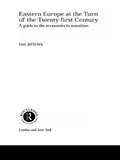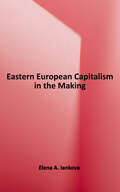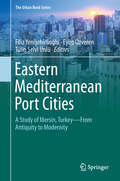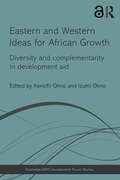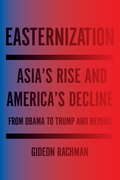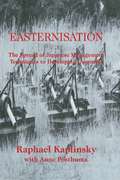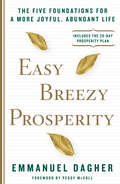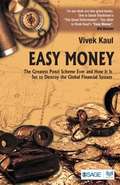- Table View
- List View
Eastern Caribbean Currency Union: Selected Issues (Imf Staff Country Reports)
by International Monetary Fund. Western Hemisphere Dept.A report from the International Monetary Fund.
Eastern Europe at the Turn of the Twenty-First Century: A Guide to the Economies in Transition (Routledge Studies Of Societies In Transition Ser. #No.19)
by Ian JeffriesFollowing on from Jeffries' 2001 Economies in Transition: A Guide to China, Cuba, Mongolia, North Korea and Vietnam at the Turn of the Twenty-First Century, this comprehensive survey of economic and political change focuses on the countries of Eastern Europe. Jeffries also discusses the general issues involved in economic transition, including `big
Eastern European Capitalism in the Making
by Elena A. IankovaThis book examines the relationships between governments, labor, and business in central and eastern Europe as capitalism develops. The triple forum for social dialogue, termed "tripartism," is a new post-communist species of state-society interaction and a brand of capitalism distinct from American neo-liberalism, western European neo-corporatism, and Japanese statism. Through political negotiations, civic participation, and multi-level bargaining, tripartism institutionalizes--and thereby contains and channels--conflict among post-communist social actors in the industrial arena. Variations in the establishment and functioning of tripartite institutions across central and eastern European countries, industries, and regions reflect differing corporatist legacies and differing paths taken to effect extrication from state socialism. Integration into the international economy and polity, especially European integration, has somewhat diminished differences and, in the long run, is helping preserve and maintain social dialogue structures in the central and eastern European region.
Eastern European Music Industries and Policies after the Fall of Communism: From State Control to Free Market (Routledge Russian and East European Music and Culture)
by Patryk GaluszkaEastern Europe during the last thirty years has been a place of radical political, economic, and social transformation, and these changes have affected the cultural industries of various countries. Thirteen chapters by a selection of leading international researchers document the stories of various organisations that once dominated the ‘communist music industries’, such as state-owned record companies, music festivals, and collecting societies. The strategies employed by artists and industries to join international music markets after the fall of communism are explained and evaluated. Political and economic transformations coincided with the advent of digitalisation and the Internet, which intensified the changes. All these issues posed challenges both to record labels and artists who, after adjusting to the rules of the free-market economy, were faced with the falling sales of records caused by the advent of new communication technologies. This book examines how these processes have affected the music industries, scenes, and markets in various Eastern European countries
Eastern European Perspectives on the Development of Public Relations: Other Voices
by Tom Watson Lisa G. JohnstonThe National Perspectives on the Development of Public Relations: Other Voices series is the first to offer an authentic world-wide view of the history of public relations. It will feature six books, five of which will cover continental and regional groups. This second book in the series focuses on Eastern Europe.
Eastern Mediterranean Port Cities: A Study Of Mersin, Turkey-from Antiquity To Modernity (The Urban Book Series)
by Filiz Yenişehirlioğlu Eyüp Özveren Tülin Selvi ÜnlüThis book surveys the historical development, current problems and likely prospects for Eastern Mediterranean port cities, providing contributions from scholars from various disciplines, such as archaeologists, historians, economists, urban planners and architects. By studying the city of Mersin and the surrounding area, it offers insights into the changing nature of Eastern Mediterranean port cities.The first part of the book discusses the approaches to the Mediterranean World, from the late prehistory to the present, and questions the implications of the values inherited from the past for a sustainable future. The second part then examines the social structure of Eastern Mediterranean port cities presenting an in-depth study of different ethnic groups and communities. In the third part the changing physical structure of these cities is elucidated from the perspectives of archaeology, architecture, and urban planning. The last part focuses on urban memory through a detailed study based on live recordings of original accounts by the local people. The book benefits prospective researchers in the field of Mediterranean studies, archaeology, history, economic history, architecture and urban planning.
Eastern North Carolina Farming
by Frank Stephenson Barbara Nichols MulderSettled as a maritime and agricultural colony, North Carolina's history has always been intertwined with agriculture and farming. After the Civil War, North Carolina became the nation's top grower of tobacco, and one of the country's largest tobacco companies--the American Tobacco Company--flourished from the huge quantities of Eastern North Carolina-grown tobacco that was purchased. With the growing success of cotton farming and other crops and livestock--including corn, peanuts, and hogs--the region was particularly rich in subsistence farming. Over the course of the 20th century, farming and agriculture went through tremendous change. The familiar landscape of cotton and tobacco began to shift and include more varied crops, such as soybeans and sweet potatoes. At the same time, hand tools were exchanged for tractors and combines. Eastern North Carolina Farming showcases the rich history of this agriculturally dynamic region while telling the individual stories of farmers who grew for families, markets, and distribution.
Eastern and Cross Cultural Management
by N. K. SinghThis path-breaking book liberates management thinking from a century of Western subjugation. It is a comparative exposition of culture and management styles in India, Japan, China and major Western countries. There is a need to protect and sustain each country's identity and positive strengths in values while interlinking global business with cross cultural empathy. The book explores profiles of culture-management axis through secondary literature study in various languages of the East, empirical research conducted with nearly one thousand managers and 375 organizations in India. The effective management in the next millennium will be mission-based strategic integration of the team, combined with people-sensitive approach. In spite of growth of hi-tech, the emotional human issues will dominate the coming decades. Happiness and health in institutions will largely depend on successive sacrifice of greed and possessiveness in creation of wealth for human development. The meltdown in the US and its repercussions in the world are direct outcome of failure to learn these lessons. Already the world is witnessing acute consciousness of interdependence and universal linkages. This is the quintessence of Vedanta, Zen-Buddhism and Sufi order in the Eastern globe. West-dominated management technology must now synthesize with Eastern intuition and values. The book is divided into three parts: First part delves into East-West psyche; second part presents Integration-Affection Model as potential approach to effective Management. Third part shows the author's successful applications of the approach in different organizations while working as Chief Executive or Consultant.
Eastern and Western Ideas for African Growth: Diversity and Complementarity in Development Aid (Routledge-GRIPS Development Forum Studies)
by Kenichi Ohno Izumi OhnoThe West and the East approach economic development differently. The Europeans and Americans stress free and fair business climate, promoting private activities generally without picking winners, and improving governance. East Asia is interested in achieving concrete results and projects rather than formal correctness, prioritizing a few sectors for industrialization, and eventual graduation from aid. The West mostly shapes shifting strategies of the international donor community while the East has in reality made remarkable progress in industrial catch-up. The two approaches cannot be merged easily but they can be used in proper combination to realize growth and economic transformation. This book proposes more dialogue and complementarity between the two in the development effort of Africa and other regions. In this collected volume, contributed by experts and practitioners from both East and West, the need to introduce Eastern ideas to the global development strategy is emphasized. Analysis of British and other Western donor policies is given while Japanese, Korean, and other Asian approaches are also explained with concrete examples. The concept of governance for growth is presented and the impact of rising China on development studies is contemplated. The practices of industrial policy dialogues and actions assisted by East Asian experts are reported from Tunisia, Zambia, Ethiopia, Rwanda, and others. The book should be applicable to all donors, institutions, NGOs and business enterprises engaged in development cooperation.
Easternization: Asia's Rise and America's Decline From Obama to Trump and Beyond
by Gideon RachmanFrom the winner of the 2016 Orwell Prize and the European Press Prize for Commentator of the Year, a provocative analysis of how a new era of global instability has begun, as the flow of wealth and power turns from West to East. Easternization is the defining trend of our age — the growing wealth of Asian nations is transforming the international balance of power. This shift to the East is shaping the lives of people all over the world, the fate of nations, and the great questions of war and peace. A troubled but rising China is now challenging America’s supremacy, and the ambitions of other Asian powers — including Japan, North Korea, India, and Pakistan — have the potential to shake the whole world. Meanwhile the West is struggling with economic malaise and political populism, the Arab world is in turmoil, and Russia longs to reclaim its status as a great power. As it becomes clear that the West’s historic power and influence is receding, Gideon Rachman offers a road map to the turbulent process that will define the international politics of the twenty-first century.
Easternization: The Spread of Japanese Management Techniques to Developing Countries
by Raphael Kaplinsky Anne PosthumaJapanese industry has shown its superiority in a range of traded goods sectors. It was thought that this competitive advantage arose from the use of electronics-based flexible automation technologies, but it is now clear that the major source of this industrial strength is in the development and diffusion of new management techniques such as just-in-time production and total quality management.A number of Western firms have begun to introduce these management techniques and have begun to reap significant benefits, not just in lowering costs but also in improving product variety and quality, and in being able to satisfy customer needs more effectively. This is a practical and relevant book for those involved in the areas of policy and production, as well as being of relevance to those in the teaching and research communities.
Eastman Chemical Co.: Building a Board from Scratch
by Jay W. Lorsch Samantha K. GraffEastman Chemical Co. spun off from Kodak in 1993. The CEO of Eastman, Earnest Deavenport did not want the new company's board any members of the Kodak board to include, so he initiated a deliberate and thorough process to build an entirely new board that he hoped would be on the cutting edge. This case describes the selection process and documents the backgrounds of the chosen directors. Discusses the board's first year at work, and it records the reflections "one year in" of Deavenport and some of the board members.
Eastman Kodak Co.: Funtime Film
by Robert J. DolanEastman Kodak has suffered significant declines in film market share at the hands of lower priced branded producers and private label products. The case presents Kodak's proposal to launch a new economy brand of film to combat these rivals.
Eastman Kodak Co.: Managing Information Systems Through Strategic Alliances
by Lynda M. Applegate Ramiro MontealegreIn January 1988, Colby Chandler, Kodak CEO, created the Corporate Information Systems (CIS) and appointed Katherine Hudson head. She at once became the first head of IT and first woman corporate vice president in the company. Throughout 1989, Hudson inaugurated a series of organizational initiatives that not only would dramatically change the IT function within Kodak, but would rock the industry. She outsourced data center operations, telecommunications services, and personal computer support to IBM, DEC, and Business Land, respectively. Case presents the complexities in managing information systems through partnerships.
Eastman Kodak Co.: Managing Information Systems Through Strategic Alliances
by Lynda M. Applegate Ramiro MontealegreIn January 1988, Colby Chandler, Kodak CEO, created the Corporate Information Systems (CIS) and appointed Katherine Hudson head. She at once became the first head of IT and first woman corporate vice president in the company. Throughout 1989, Hudson inaugurated a series of organizational initiatives that not only would dramatically change the IT function within Kodak, but would rock the industry. She outsourced data center operations, telecommunications services, and personal computer support to IBM, DEC, and Business Land, respectively. Case presents the complexities in managing information systems through partnerships.
Eastman Kodak Company: Restructuring a Melting Ice Cube
by Stuart C. Gilson Sarah L. Abbott John D. DionneIn May 2013, senior managers of GSO Capital Partners, an $80 billion credit-oriented investment firm owned by The Blackstone Group, are considering what to do next with their investment in the senior secured debt of Eastman Kodak Company. Once a great company and an icon of American business, Kodak had fallen on desperately hard economic times as its traditional business of manufacturing cameras and photographic film had all but disappeared with the rise of digital photography, causing its annual revenues to plummet from $13 billion to $6 billion, and its stock price to fall by 95%, between 2003 and 2011. Having taken various positions in Kodak's debt during the previous four years, GSO is now faced with a major decision. Under the company's recently proposed plan of reorganization, secured creditors were to be given 85% of the company's common stock, but unsecured creditors objected to the plan. Now, six months later, GSO has brought an amended plan to the table, under which it would commit to backstop a $406 million equity rights offering that would be made directly to all the unsecured creditors. This offer might bring the objecting creditors on board, but could also require an additional large capital commitment by GSO, which was already heavily invested in a highly troubled business that many viewed as a "melting ice cube."
Eastman Kodak Company: Restructuring a Melting Ice Cube
by Stuart C. Gilson Sarah L. Abbott John DionneIn May 2013, senior managers of GSO Capital Partners, an $80 billion credit-oriented investment firm owned by The Blackstone Group, are considering what to do next with their investment in the senior secured debt of Eastman Kodak Company. Once a great company and an icon of American business, Kodak had fallen on desperately hard economic times as its traditional business of manufacturing cameras and photographic film had all but disappeared with the rise of digital photography, causing its annual revenues to plummet from $13 billion to $6 billion, and its stock price to fall by 95%, between 2003 and 2011. Having taken various positions in Kodak's debt during the previous four years, GSO is now faced with a major decision. Under the company's recently proposed plan of reorganization, secured creditors were to be given 85% of the company's common stock, but unsecured creditors objected to the plan. Now, six months later, GSO has brought an amended plan to the table, under which it would commit to backstop a $406 million equity rights offering that would be made directly to all the unsecured creditors. This offer might bring the objecting creditors on board, but could also require an additional large capital commitment by GSO, which was already heavily invested in a highly troubled business that many viewed as a "melting ice cube."
Eastwind Trading Co. (A)
by Howard H. Stevenson Martha GershunTwo professional women are contemplating a business venture. They must assess the nature of the opportunity, what options it opens if they are to pursue the venture, and how they might finance the new business. A rewritten version of an earlier case.
Easy Breezy Prosperity: The Five Foundations for a More Joyful, Abundant Life
by Emmanuel DagherEasy Breezy Prosperity is a holistic guide to discover and nurture prosperity and align your life with your spiritual core. Author Emmanuel Dagher redefines what real prosperity means and offers you tactics to expand and enrich yourself well beyond financial goals. By examining how and why we treat money the way we do, Dagher shows you how to realize the success you have already created and cultivate the clarity needed to attract more of it in your daily life. Each chapter is designed to empower you, leaving you feeling optimistic not only about their working lives and finances, but also your entire life's path.Dagher shares his own story and those of his clients and fans who have turned their lives around using his meditations, rituals, and exercises. He also includes a 28-day plan with simple yet effective daily practices you can use, such as: • Expressing gratitude each morning for all that you have • Cultivating a healthy relationship with money through "money healing" practices • Seeking out opportunities to be of service through your time, energy, gifts, or abilities • De-cluttering your space and mind to allow positivity to enterEasy Breezy Prosperity is a powerfully motivating plan to take action, strengthen self-confidence, and enjoy a more joyful and abundant life.
Easy Economics: A Visual Guide to What You Need to Know
by Leonard WolfeLet's face it, economics can be boring…but we all need a decent understanding of the basics if we want to survive in these difficult and uncertain times. Let's make it more interesting. Easy Economics isn't packed with reams of text or stacks of numbers, this book is visual and engaging. The book aims to bring you up to speed, in a way that entertains while it informs, through a collection of many of the most frequently asked questions--plus some you probably haven't thought of--on the subject of economics. The topics range from: The difference between Debt and Deficit Causes and cures of recessions The Financial Crisis of 2007-2009 explained Is globalization good or bad? How fiscal and monetary policies differ Bubbles and Busts Unlike so many other books on the subject, it explains through a Q & A format with entertaining and informative illustration, providing material that many people ordinarily find uninviting and even intimidating in an easy-to-digest, appealing way.
Easy Guide to Health and Safety
by Phil Hughes Liz HughesDo you need to get to grips with health and safety principles but don’t have time to wade through reams of legislation and guidance? Do you need practical step-by-step guidance on health and safety issues for your small business? Then this is the book for you. Building on the success of the first edition, this fully revised Easy Guide to Health and Safety 2nd edition introduces the health and safety issues which the self-employed and managers, directors and staff with health and safety responsibilities in small businesses face every day. Written in plain English, this new edition will take you through the principles of health and safety in a clear, jargon-free manner. Fully revised and packed with practical guidance, the Easy Guide to Health and Safety will ensure that you are well equipped to keep yourself and others safe in the workplace. Provides small businesses with the necessary information to understand obligations and gain control of health and safety in the workplace Packed with practical guidance and handy checklists and forms. Also suitable for students studying towards IOSH Working Safely and NVQ level 1 and 2 courses from City and Guilds and other NVQ awarding bodies.
Easy Living: The Rise of the Home Office
by Elizabeth A PattonHow did Americans come to believe that working at home is feasible, productive, and desirable? Easy Living examines how the idea of working within the home was constructed and disseminated in popular culture and mass media during the twentieth century. Through the analysis of national magazines and newspapers, television and film, and marketing and advertising materials from the housing, telecommunications, and office technology industries, Easy Living traces changing concepts about what it meant to work in the home. These ideas reflected larger social, political-economic, and technological trends of the times. Elizabeth A. Patton reveals that the notion of the home as a space that exists solely in the private sphere is a myth, as the social meaning of the home and its market value in relation to the public sphere are intricately linked.
Easy Money
by Joel GibsonDiscover bill-buster Joel Gibson&’s simple money-saving system for a post-COVID world where everything is more expensive! Australian households have survived a once-in-a-century pandemic and the toughest cost of living crisis in a generation. But most of us are still paying businesses and governments hundreds or thousands more than we have to. Get some of that money back, with minimal effort, and it could be the easiest $1000+ you&’ve ever earned. Some of Joel&’s tips include: • Crucial updates on the EASIEST ways to slash energy, telco, insurance and housing costs • Simple NEW money-saving hacks for getting a better deal on groceries and petrol • How to save HUNDREDS on streaming and pay TV • How to see if you own a share of the BILLIONS in &‘free money&’ held by governments and banks Originally published as Kill Bills!, this updated and expanded edition might just make you feel good about money.
Easy Money
by Vivek Kaul"A man hears what he wants to hear and disregards the rest," wrote singer and songwriter Paul Simon some decades back. Books on the current financial crisis which started in late 2008 are a tad like that. Until now they have tended to deal with certain aspects of the crisis without looking at the bigger picture of what really went wrong. That bigger picture of the ongoing financial crisis has now started to evolve. Easy Money captures this big picture. The history of money and the financial system as it has evolved over the centuries stand at the heart of this endeavor. It explores the idea that the evolution of money over centuries has led to an easy money policy being followed by governments and central banks across the world, which in turn has fueled humongous Ponzi schemes, which have now started to unravel, bringing the whole world on the brink of a financial disaster. The book also explains how the lessons of the financial crisis have still not been learned, and in trying to deal with it, governments across the world are making the same mistakes which led to the current crisis in the first place.
Easy Money: American Puritans and the Invention of Modern Currency (Markets and Governments in Economic History)
by Dror GoldbergA sweeping history of the American invention of modern money. Economists endlessly debate the nature of legal tender monetary systems—coins and bills issued by a government or other authority. Yet the origins of these currencies have received little attention. Dror Goldberg tells the story of modern money in North America through the Massachusetts colony during the seventeenth century. As the young settlement transitioned to self-governance and its economy grew, the need to formalize a smooth exchange emerged. Printing local money followed. Easy Money illustrates how colonists invented contemporary currency by shifting its foundation from intrinsically valuable goods—such as silver—to the taxation of the state. Goldberg traces how this structure grew into a worldwide system in which, monetarily, we are all Massachusetts. Weaving economics, law, and American history, Easy Money is a new touchstone in the story of monetary systems.

